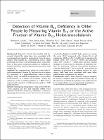| dc.contributor.author | MOLLOY, ANNE MARIE | |
| dc.contributor.author | SCOTT, JOHN MARTIN | |
| dc.date.accessioned | 2009-11-04T09:30:04Z | |
| dc.date.available | 2009-11-04T09:30:04Z | |
| dc.date.issued | 2007 | |
| dc.date.submitted | 2007 | en |
| dc.identifier.citation | R. Clarke, P. Sherliker, H. Hin, E. Nexo, A.M. Hvas, J. Schneede, J. Birks, P.M. Ueland, K. Emmens, J.M. Scott, A.M. Molloy, J.G. Evans `Detection of vitamin B12 deficiency in older people by measuring vitamin B12 or the active fraction of vitamin B12, holotranscobalamin? in Clinical Chemistry, 53, (5), 2007, pp 963 - 970 | en |
| dc.identifier.other | Y | |
| dc.identifier.other | 49988 | |
| dc.identifier.other | Y | en |
| dc.identifier.uri | http://hdl.handle.net/2262/34492 | |
| dc.description | PUBLISHED | en |
| dc.description.abstract | Background: Impaired vitamin B12 function and decreased vitamin B12 status have been associated with neurological and cognitive impairment. Current assays analyze total vitamin B12 concentration, only a small percentage of which is metabolically active. Concentrations of this active component, carried on holotranscobalamin (holoTC), may be of greater relevance than total vitamin B12.
Methods: We compared the utility of serum holoTC with conventional vitamin B12 for detection of vitamin B12 deficiency in a population-based study of older people, using increased methylmalonic acid (MMA) concentrations as a marker of metabolic vitamin B12 deficiency in the overall population (n = 2403) and in subsets with normal (n = 1651) and abnormal (n = 752) renal function.
Results: Among all participants, 6% had definite (MMA >0.75 ?mol/L) and 16% had probable (MMA >0.45 ?mol/L) metabolic vitamin B12 deficiency. In receiver operating characteristic curves for detection of definite vitamin B12 deficiency, holoTC had a greater area under the curve (AUC) compared with vitamin B12 in all participants (0.85 vs 0.76; P <0.001) and in subsets with normal (AUC: 0.87 vs 0.79; P <0.001) and abnormal (AUC: 0.85 vs 0.74; P = 0.002) renal function. Similar findings were observed for detection of moderate vitamin B12 deficiency. Whereas the positive predictive value for both holoTC and vitamin B12 was greater for detection of probable than definite vitamin B12 deficiency, both tests were associated with more false-positive than true-positive test results.
Conclusions: HoloTC has a modestly superior diagnostic accuracy compared with conventional vitamin B12 for the detection of vitamin B12 deficiency, but neither test can be recommended to screen asymptomatic populations. | en |
| dc.description.sponsorship | Grant/funding support: The MRC CFAS program was funded by the Medical Research Council and the Department of Health. Blood collection and analysis was supported by grants from the Medical Research Council, European Union (EU) (QLK3-CT-2002-01775), Health Foundation, London (554/1236), Food Standards Agency, Clothworkers Foundation, and the Joan Dawkins Foundation of the British Medical Association. | en |
| dc.format.extent | 963 | en |
| dc.format.extent | 970 | en |
| dc.format.extent | 179113 bytes | |
| dc.format.mimetype | application/pdf | |
| dc.language.iso | en | en |
| dc.publisher | American Association for Clinical Chemistry | en |
| dc.relation.ispartofseries | Clinical Chemistry | en |
| dc.relation.ispartofseries | 53 | en |
| dc.relation.ispartofseries | 5 | en |
| dc.rights | Y | en |
| dc.subject | Clinical Medicine | en |
| dc.title | Detection of vitamin B12 deficiency in older people by measuring vitamin B12 or the active fraction of vitamin B12, holotranscobalamin. | en |
| dc.type | Journal Article | en |
| dc.contributor.sponsor | Medical Research Council | |
| dc.contributor.sponsor | European Union (EU) | |
| dc.type.supercollection | scholarly_publications | en |
| dc.type.supercollection | refereed_publications | en |
| dc.identifier.peoplefinderurl | http://people.tcd.ie/amolloy | |
| dc.identifier.rssuri | http://dx.doi.org/10.1373/clinchem.2006.080382 | |




